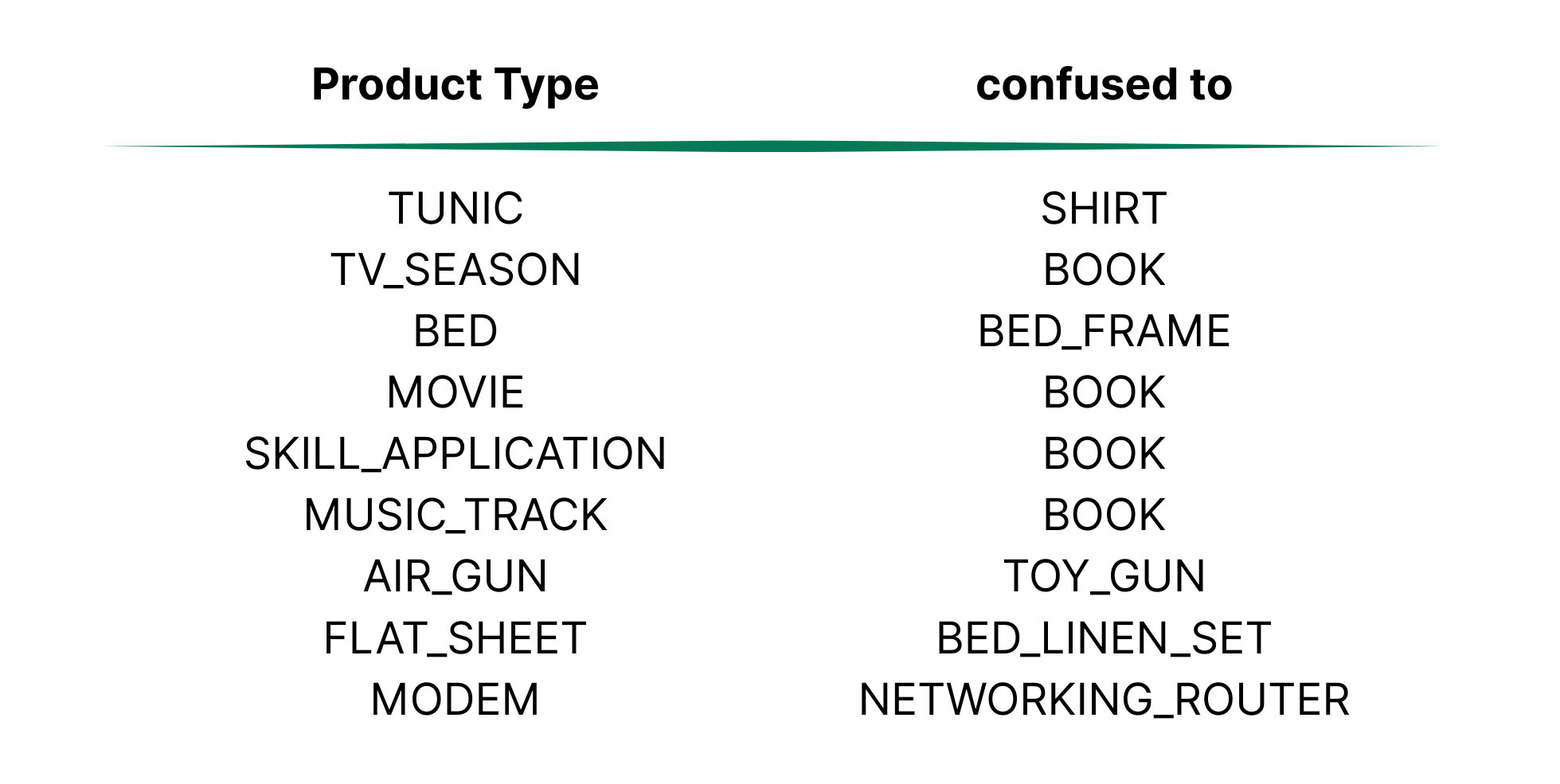
Amazon Product Types & Keywords: Why AI Categorization Fails
Amazon’s AI categorization system misclassifies products in approximately 20% of cases, according to recent research. These errors dramatically impact product visibility, causing relevant items to appear under wrong categories and drastically reducing their discoverability in search results.
This comprehensive guide reveals why Amazon’s automated product type classification fails, using findings from Amazon’s own sQuIrRel study. You’ll discover the three main problem areas causing misclassifications and learn actionable strategies to monitor and optimize your product categorization for maximum visibility and revenue.
Automation vs. Precision
In recent years, the increasing automation in e-commerce has led to a widespread assumption: search engines and marketplaces are now so well optimized that manual categorization and keywords hardly matter anymore. Modern algorithms are expected to automatically understand what customers are searching for and display the matching products—regardless of whether a query is precisely or vaguely formulated.
However, a recent Amazon study on e-commerce query classification disproves this assumption. It shows that particularly in automatic classification of search queries, errors occur that directly affect the visibility and sales potential of products on marketplaces like Amazon. When a search query is assigned to the wrong product type, relevant products show up under irrelevant categories and are associated with less appropriate keywords—drastically affecting their discoverability.
Where Search Algorithms Fall Short
The study highlights that search queries are often ambiguous or unclear in practice. Customers use synonyms, colloquial expressions, or generic phrases that algorithms must interpret. This results in misclassifications and reduces the relevance of the search results. There are specifically three main problem areas.
Problem Area 1: Misclassifications in Media Products
A major issue is the misclassification in media products. The study shows that the product type “Book” is frequently wrongly assigned to other media formats such as “Movie”, “TV Season”, “Music Track”, or “Skill Application”. This likely happens due to similar or identical titles and descriptions. A concrete example from the study illustrates this: the query “Follow Me” was assigned to the category “Book” in Singapore, because many books bear this title. However, in that local market, the query usually refers to a popular shampoo brand. Such errors cause customers to see unexpected results and relevant listings to go missing from search results.

Problem Area 2: Shifting Purchase Intentions and Synonyms
Another issue arises when algorithms rely heavily on aggregated click-through data. These errors happen especially when customers change their original purchase intention during the search or when the algorithm fails to clearly distinguish between synonyms or similar product types.
For example, the study shows that queries like “integrated graphics” were mostly assigned to “Notebook Computers”, although technically “Video Card” was more accurate. This might be because customers clicking on such a search mostly chose notebooks with integrated graphics.
Another example involved a query for “mop bucket” being wrongly assigned to a “Mop Bucket Set” instead of simply “Bucket”. Similarly, the query “carry on luggage” was interpreted by the system as “Backpack” rather than the correct category “Suitcase”.

Problem Area 3: Confusion with Complementary Product Types
This third issue involves confusion between complementary product types. The study shows that thematically related products, but with different purchase intentions, are often mixed up. For example, a “vacuum cleaner handle” being incorrectly classified under “Vacuum Cleaner”. While it’s a relevant part, customers searching for “Vacuum Cleaner” expect a complete product — not an accessory.
Similar issues occur in other categories. For instance, “Bed” and “Bed Frame” were sometimes mixed, even though they serve different purposes and triggers for purchase.
Manual verification of the study results showed that about 20% of assignments for complementary product types — such as accessories versus the main product — were incorrect. This highlights that even advanced models struggle to differentiate between closely related but differently purposed product types.
These examples demonstrate why Amazon sellers must actively monitor the product type classification of their listings. While sellers cannot influence the way search queries are interpreted by Amazon’s algorithm, they are responsible for ensuring their products are correctly classified. A wrong classification during listing setup or a later automatic reclassification by Amazon can seriously hurt visibility.
Sellers should carefully monitor every change in product type classification — using tools like AMALYTIX that highlight such changes—to prevent the following risks:
-
Missed revenue opportunities: Mislabeled products won’t show up in relevant search results, causing customers to miss your offering.
-
Increased risk in automated ad campaigns: Misclassified products may appear in less relevant search ads, leading to wasted ad spend. While manual campaigns rely more heavily on keyword control, the initial category still matters.
-
Long-term visibility loss: Amazon ranks products based on performance metrics like click-through and conversion rates. Misclassified products may underperform and drop in rankings over time.
These classification errors illustrate how search algorithms handle ambiguous or vague queries and why precise product categorization by sellers is key. While Amazon decides how to interpret a search, sellers are responsible for assigning the correct category during product creation. This is crucial for better discoverability for relevant queries, especially as Amazon’s AI tools continue to evolve and impact search results.
The sQuIrRel Model and Its Significance
The study was conducted using a specially developed model called sQuIrRel (Query Intent from Relevance). Its goal is to evaluate the accuracy of query-to-product-type (Q2PT) classifications — i.e., how well an algorithm can assign a customer query to an appropriate product type.
Traditionally, these classifications were validated in two ways:
-
Manually labeled datasets: Experts or crowdworkers assign each search query to the correct product category. This is highly accurate but expensive and time-intensive.
-
Click-through data: Analyzing which products users click after a search. However, this data can be skewed, as users may click on different items than what they originally intended to buy.
The sQuIrRel model offers a new approach: it automatically collects datasets by assessing the relationship between queries and products, deriving precise mappings without manual labeling.

It begins with search logs that contain queries and their search results. A relevance model filters for exact matches between the query and product. Then it assigns the product types of the matching items to the respective queries. Only types with at least three supporting products per query are considered.
Vague types are removed afterward, and the number of queries per product type is limited to a maximum of 50 to ensure balanced distribution.
The result: thousands of search queries cleanly matched with their product types — without manual categorization or flawed click data.
One of sQuIrRel’s key advantages is scalability. While manual classification is expensive, sQuIrRel can continuously generate updated, accurate classifications, adapting to new products and market trends.
The final dataset included over 2.7 million queries from 20 Amazon marketplaces and covered around 1,500 product types.
The Importance of Product Type Categorization
As the study shows, precise product categorization is essential for visibility on Amazon. Misclassifications lead to missing out on relevant queries or being found under irrelevant ones. Sellers should regularly review three aspects:
-
Competitors: How are competing products classified, and do they gain a visibility advantage from it?
-
Amazon’s categorization logic: Have there been product catalog updates or new types introduced that allow for finer classification?
-
Customer intent: Does the categorization match what customers expect? Feedback in reviews or FAQs can help identify if a change might be needed.
Tip: Want to learn more about how Amazon uses categories and product types and how you can audit yours? Check out our detailed guide: Amazon Categories and Product Types – How It All Fits Together.
Monitor Product Categorization with AMALYTIX
AMALYTIX offers tools to help sellers check and optimize their product type assignments easily and regularly.
Practical Insight: Why Categorization Alone Isn’t Enough
Is accurate product type categorization enough to succeed on Amazon? No. While it’s necessary, it’s not sufficient. Other factors, particularly keyword optimization, play a key role.
The Interaction Between Categories and Keywords
Product categorization defines the baseline for relevance. It decides if your listing shows up for a query at all. Keywords go a step further — making products visible within that category.
Even simple keyword patterns remain vital for Amazon’s relevance engine, reinforcing the idea that keywords influence ranking.
Example: A yoga mat categorized under “Sports & Outdoors > Fitness > Yoga Mats” is visible for “yoga mat”, but only keywords like “non-slip”, “extra wide” or “eco-friendly” ensure it ranks well for specific queries. Sellers should include these in titles, bullet points, and descriptions to signal query relevance to the system.
Why Sellers Must Align Category and Keyword Strategy
To ensure sustained visibility, category and keyword strategy must go hand in hand. Specialized tools like AMALYTIX help uncover real user search terms that matter within your product categories. These should be placed in your listings to strengthen your match for those queries.
Because AI models still struggle with vague terms, choosing clear, unambiguous keywords is more important than ever.
In short: Only sellers who continuously align product type categorization and keyword usage will maximize discoverability in Amazon search.
AI Cannot Replace a Thoughtful Categorization and Keyword Strategy
While the automation of product search continues to improve, the study shows that automatic classification — especially for semantically similar or complementary types — still has weaknesses. This is particularly important as Amazon Rufus and other AI-driven features rely on accurate categorization to make recommendations.
Future research aims to better interpret vague queries and combine click-through data more intelligently with relevance signals. Understanding Rufus’s recommendation patterns can help sellers optimize their listings for AI-driven discovery.
For Amazon sellers, this means: Even if Amazon reclassifies your listings on its own, proper initial categorization, diligent monitoring, and proactive keyword optimization are still essential.
Accurate product type classification, combined with a well-thought-out keyword strategy, is the foundation for boosting visibility and staying competitive on Amazon.
Subscribe to Newsletter
Get the latest Amazon tips and updates delivered to your inbox.
Wir respektieren Ihre Privatsphäre. Jederzeit abbestellbar.
Related Articles
AI Agents in E-Commerce
What are AI agents and how do they work? We explain it in simple terms.

Christoph Vogt
Agentic Commerce Protocol (ACP): How AI Is Transforming Online Retail
With the Agentic Commerce Protocol (ACP), a new era in e-commerce begins: AI assistants like ChatGPT take over the shopping process. What does this mean for brands and online shops?

Trutz Fries
Amazon Rufus Study: 1,300+ Products Reveal AI Patterns
Statistical analysis of 1,300+ Amazon Rufus recommendations reveals key patterns: 92% Prime eligible, 4.5+ ratings, and optimal listing attributes.

Trutz Fries


